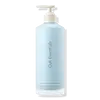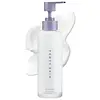What's inside
What's inside
 Key Ingredients
Key Ingredients

 Benefits
Benefits

 Concerns
Concerns

 Ingredients Side-by-side
Ingredients Side-by-side

Water
Skin ConditioningCocos Nucifera Oil
MaskingCetyl Alcohol
EmollientSimmondsia Chinensis Seed Oil
EmollientButyrospermum Parkii Butter
Skin ConditioningCetearyl Olivate
Sorbitan Olivate
EmulsifyingTanacetum Annuum Flower Oil
MaskingCoccinia Indica Fruit Extract
Skin ConditioningLavandula Angustifolia Oil
MaskingOcimum Sanctum Leaf Extract
Skin ConditioningOcimum Basilicum Flower/Leaf Extract
TonicCurcuma Longa Root Extract
MaskingSolanum Melongena Fruit Extract
Skin ConditioningRosmarinus Officinalis Leaf Extract
AntimicrobialCorallina Officinalis Extract
Skin ConditioningArgania Spinosa Kernel Oil
EmollientLinalool
PerfumingHelianthus Annuus Extract
EmollientMelia Azadirachta Leaf Extract
Skin ConditioningMelia Azadirachta Flower Extract
Skin ConditioningOryza Sativa Bran Extract
Skin ConditioningAloe Barbadensis Flower Extract
EmollientEugenol
PerfumingCoumarin
PerfumingCaprylyl Glycol
EmollientGlyceryl Stearate Se
EmulsifyingTriethyl Citrate
MaskingSodium Stearoyl Glutamate
CleansingCarbomer
Emulsion StabilisingHydroxyacetophenone
AntioxidantPotassium Sorbate
PreservativeSodium Benzoate
MaskingGlyceryl Undecylenate
EmollientGlyceryl Laurate
EmollientGlycerin
HumectantTetrasodium Glutamate Diacetate
Limonene
PerfumingTocopherol
AntioxidantGeraniol
PerfumingCitronellol
PerfumingBenzyl Benzoate
AntimicrobialCitral
PerfumingHexyl Cinnamal
PerfumingFarnesol
PerfumingCitric Acid
BufferingSodium Hydroxide
BufferingParfum
MaskingWater, Cocos Nucifera Oil, Cetyl Alcohol, Simmondsia Chinensis Seed Oil, Butyrospermum Parkii Butter, Cetearyl Olivate, Sorbitan Olivate, Tanacetum Annuum Flower Oil, Coccinia Indica Fruit Extract, Lavandula Angustifolia Oil, Ocimum Sanctum Leaf Extract, Ocimum Basilicum Flower/Leaf Extract, Curcuma Longa Root Extract, Solanum Melongena Fruit Extract, Rosmarinus Officinalis Leaf Extract, Corallina Officinalis Extract, Argania Spinosa Kernel Oil, Linalool, Helianthus Annuus Extract, Melia Azadirachta Leaf Extract, Melia Azadirachta Flower Extract, Oryza Sativa Bran Extract, Aloe Barbadensis Flower Extract, Eugenol, Coumarin, Caprylyl Glycol, Glyceryl Stearate Se, Triethyl Citrate, Sodium Stearoyl Glutamate, Carbomer, Hydroxyacetophenone, Potassium Sorbate, Sodium Benzoate, Glyceryl Undecylenate, Glyceryl Laurate, Glycerin, Tetrasodium Glutamate Diacetate, Limonene, Tocopherol, Geraniol, Citronellol, Benzyl Benzoate, Citral, Hexyl Cinnamal, Farnesol, Citric Acid, Sodium Hydroxide, Parfum
Water
Skin ConditioningCocos Nucifera Oil
MaskingCetyl Ethylhexanoate
EmollientGlycerin
HumectantOryza Sativa Bran Oil
EmollientPropanediol
SolventGlyceryl Stearate Se
EmulsifyingAdansonia Digitata Seed Oil
EmollientCitrullus Lanatus Seed Oil
EmollientTheobroma Cacao Seed Butter
EmollientButyrospermum Parkii Butter
Skin ConditioningMangifera Indica Seed Butter
Skin ConditioningMalpighia Punicifolia Fruit Extract
AntioxidantTocopherol
AntioxidantTocopheryl Acetate
AntioxidantCaprylic/Capric Triglyceride
MaskingCetearyl Alcohol
EmollientPotassium Cetyl Phosphate
EmulsifyingEthylhexylglycerin
Skin ConditioningCarbomer
Emulsion StabilisingSodium Hydroxide
BufferingBenzyl Salicylate
PerfumingDimethicone
EmollientPolysorbate 60
EmulsifyingPhenoxyethanol
PreservativeParfum
MaskingHexyl Cinnamal
PerfumingLimonene
PerfumingLinalool
PerfumingWater, Cocos Nucifera Oil, Cetyl Ethylhexanoate, Glycerin, Oryza Sativa Bran Oil, Propanediol, Glyceryl Stearate Se, Adansonia Digitata Seed Oil, Citrullus Lanatus Seed Oil, Theobroma Cacao Seed Butter, Butyrospermum Parkii Butter, Mangifera Indica Seed Butter, Malpighia Punicifolia Fruit Extract, Tocopherol, Tocopheryl Acetate, Caprylic/Capric Triglyceride, Cetearyl Alcohol, Potassium Cetyl Phosphate, Ethylhexylglycerin, Carbomer, Sodium Hydroxide, Benzyl Salicylate, Dimethicone, Polysorbate 60, Phenoxyethanol, Parfum, Hexyl Cinnamal, Limonene, Linalool
Ingredients Explained
These ingredients are found in both products.
Ingredients higher up in an ingredient list are typically present in a larger amount.
This ingredient is also known as shea butter. It is an effective skin hydrator and emollient.
Emollients help soothe and soften your skin. It does this by creating a protective film on your skin. This barrier helps trap moisture and keeps your skin hydrated. Emollients may be effective at treating dry or itchy skin.
Shea butter is rich in antioxidants. Antioxidants help fight free-radicals, or molecules that may harm the body. It is also full of fatty acids including stearic acid and linoleic acid. These acids help replenish the skin and keep skin moisturized.
While Shea Butter has an SPF rating of about 3-4, it is not a sunscreen replacement.
Shea butter may not be fungal acne safe. We recommend speaking with a professional if you have any concerns.
Learn more about Butyrospermum Parkii ButterCarbomer is a polymer of acrylic acid. Its main role is to create a gel consistency.
A high amount of carbomer can cause pilling or balling up of products. Don't worry, most products contain 1% or less of carbomer.
Cocos Nucifera Oil is obtained from the kernels of the coconut fruit. In other words, this is coconut oil.
Coconut Oil is rich in fatty acids with lauric acid making up the majority of these. It also contains linoleic acid. Due to this high fatty acid content, coconut oil helps trap moisture and soften skin.
Despite being antibacterial, coconut oil may not be great for acne-prone skin. It is comedogenic and may clog pores. This ingredient may not be safe for malassezia or fungal acne.
Note: Coconut Oil should not replace your sunscreen for UV protection. Studies show it only blocks about 20% of UV.
This oil is non-volatile and has a light scent.
The term 'fragrance' is not regulated in many countries. In many cases, it is up to the brand to define this term. For instance, many brands choose to label themselves as "fragrance-free" because they are not using synthetic fragrances. However, their products may still contain ingredients such as essential oils that are considered a fragrance.
Learn more about Cocos Nucifera OilGlycerin is already naturally found in your skin. It helps moisturize and protect your skin.
A study from 2016 found glycerin to be more effective as a humectant than AHAs and hyaluronic acid.
As a humectant, it helps the skin stay hydrated by pulling moisture to your skin. The low molecular weight of glycerin allows it to pull moisture into the deeper layers of your skin.
Hydrated skin improves your skin barrier; Your skin barrier helps protect against irritants and bacteria.
Glycerin has also been found to have antimicrobial and antiviral properties. Due to these properties, glycerin is often used in wound and burn treatments.
In cosmetics, glycerin is usually derived from plants such as soybean or palm. However, it can also be sourced from animals, such as tallow or animal fat.
This ingredient is organic, colorless, odorless, and non-toxic.
Glycerin is the name for this ingredient in American English. British English uses Glycerol/Glycerine.
Learn more about GlycerinGlyceryl Stearate Se is a self-emulsifying (SE) form of glyceryl stearate. Self-emusifying means this ingredient automatically blends with water. It is an emulsifier, emollient, and cleansing agent.
As an emulsifier, Glyceryl Stearate Se prevents ingredients such as oil and water from separating. It is also a surfactant, meaning it helps cleanse the skin. Surfactants help gather oil, dirt, and other pollutants so they may be rinsed away easily.
Emollients help your skin stay smooth and soft. It does so by creating a film on top of the skin that helps trap moisture in.
Learn more about Glyceryl Stearate SeHexyl Cinnamal is a fragrance ingredient with a similar scent to jasmine. It can be naturally found in chamomile essential oil.
This ingredient is a known EU allergen and may sensitize the skin. The EU requires this ingredient to be listed separately on an ingredients list.
Hexyl Cinnamal is not water soluble but is soluble in oils.
Learn more about Hexyl CinnamalLimonene is a fragrance that adds scent and taste to a formulation.
It's found in the peel oil of citrus fruits and other plants such as lavender and eucalyptus. The scent of limonene is generally described as "sweet citrus".
Limonene acts as an antioxidant, meaning it helps neutralize free radicals.
When exposed to air, oxidized limonene may sensitize the skin. Because of this, limonene is often avoided by people with sensitive skin.
The term 'fragrance' is not regulated in many countries. In many cases, it is up to the brand to define this term. For instance, many brands choose to label themselves as "fragrance-free" because they are not using synthetic fragrances. However, their products may still contain ingredients such as essential oils that are considered a fragrance.
Learn more about LimoneneLinalool is a fragrance and helps add scent to products. It's derived from common plants such as cinnamon, mint, citrus, and lavender.
Like Limonene, this ingredient oxidizes when exposed to air. Oxidized linalool can cause allergies and skin sensitivity.
This ingredient has a scent that is floral, spicy tropical, and citrus-like.
Learn more about LinaloolParfum is a catch-all term for an ingredient or more that is used to give a scent to products.
Also called "fragrance", this ingredient can be a blend of hundreds of chemicals or plant oils. This means every product with "fragrance" or "parfum" in the ingredients list is a different mixture.
For instance, Habanolide is a proprietary trade name for a specific aroma chemical. When used as a fragrance ingredient in cosmetics, most aroma chemicals fall under the broad labeling category of “FRAGRANCE” or “PARFUM” according to EU and US regulations.
The term 'parfum' or 'fragrance' is not regulated in many countries. In many cases, it is up to the brand to define this term.
For instance, many brands choose to label themselves as "fragrance-free" because they are not using synthetic fragrances. However, their products may still contain ingredients such as essential oils that are considered a fragrance by INCI standards.
One example is Calendula flower extract. Calendula is an essential oil that still imparts a scent or 'fragrance'.
Depending on the blend, the ingredients in the mixture can cause allergies and sensitivities on the skin. Some ingredients that are known EU allergens include linalool and citronellol.
Parfum can also be used to mask or cover an unpleasant scent.
The bottom line is: not all fragrances/parfum/ingredients are created equally. If you are worried about fragrances, we recommend taking a closer look at an ingredient. And of course, we always recommend speaking with a professional.
Learn more about ParfumSodium Hydroxide is also known as lye or caustic soda. It is used to adjust the pH of products; many ingredients require a specific pH to be effective.
In small amounts, sodium hydroxide is considered safe to use. However, large amounts may cause chemical burns due to its high alkaline.
Your skin has a natural pH and acid mantle. This acid mantle helps prevent harmful bacteria from breaking through. The acid mantle also helps keep your skin hydrated.
"Alkaline" refers to a high pH level. A low pH level would be considered acidic.
Learn more about Sodium HydroxideTocopherol (also known as Vitamin E) is a common antioxidant used to help protect the skin from free-radicals and strengthen the skin barrier. It's also fat soluble - this means our skin is great at absorbing it.
Vitamin E also helps keep your natural skin lipids healthy. Your lipid skin barrier naturally consists of lipids, ceramides, and fatty acids. Vitamin E offers extra protection for your skin’s lipid barrier, keeping your skin healthy and nourished.
Another benefit is a bit of UV protection. Vitamin E helps reduce the damage caused by UVB rays. (It should not replace your sunscreen). Combining it with Vitamin C can decrease sunburned cells and hyperpigmentation after UV exposure.
You might have noticed Vitamin E + C often paired together. This is because it is great at stabilizing Vitamin C. Using the two together helps increase the effectiveness of both ingredients.
There are often claims that Vitamin E can reduce/prevent scarring, but these claims haven't been confirmed by scientific research.
Learn more about TocopherolWater. It's the most common cosmetic ingredient of all. You'll usually see it at the top of ingredient lists, meaning that it makes up the largest part of the product.
So why is it so popular? Water most often acts as a solvent - this means that it helps dissolve other ingredients into the formulation.
You'll also recognize water as that liquid we all need to stay alive. If you see this, drink a glass of water. Stay hydrated!
Learn more about Water